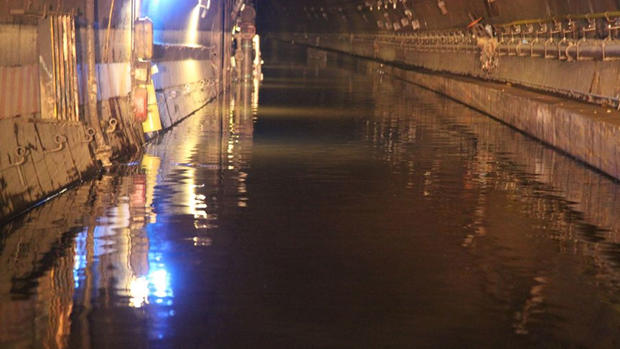What's causing gas shortages in the Northeast?
(MoneyWatch) While the price of gas is dropping across the nation, acute shortages across storm-ravaged sections of New York and New Jersey have pushed the cost up in those areas. With abundant fuel supplies elsewhere, frustrated New York and New Jersey residents wonder why they are waiting in gas lines for hours, and how long is the shortage is going to last.
The reasons for the shortage are many -- gas stations with no power, flooded tanks, an inability of fuel trucks to reach stations, and of course the panic-induced run on supplies.
Aside from some scattered reports of gouging, the price of a gallon of gas in the New York metropolitan area is up by 3 cents to 7 cents. In the rest of the nation the price has dropped 7 cents in just the last week.
The price increase is due almost entirely to the number of retail outlets shutdown by superstorm Sandy.
Even though the U.S. Energy Department reports 73 percent of gas stations in the New York metropolitan area had gasoline Sunday -- up from 62 percent on Nov. 3, that doesn't mean that they are all operational. The New Jersey Gasoline, Convenience, Automotive Association estimates that at least 75 percent of the state's gas stations were closed either because they had no gasoline, no power or both. You can go online to find stations that have gas -- for instance Hess lists all its stations and how much gas they have available
"There is a choke in the supply chain and the choke isn't in the amount of fuel that's in the region," says David Zahn, vice president of marketing for FuelQuest, which makes supply chain management software for the fuel industry. "It's the retail station -- if you don't have electricity you can't pump fuel."
Even stations with electricity are having difficulty staying supplied with gas because of damaged roads and difficulties coordinating deliveries from suppliers. Millions of gallons of gasoline are sitting in storage tanks, pipelines and tankers that can't unload their cargoes.
It may come as a surprise to people who have had to wait in line for hours to get gas, but demand for fuel in the storm-hit parts of New York and New Jersey is actually down. People are taking fewer trips because of damage to roads, cars, homes and businesses.
The lines are forming because there are so many fewer stations operating.
"Even if demand is curtailed it's being funneled to the select stations that do have fuel or do have access to supply," says Zahn. "You are going to have demand spikes that are going to cause run outs at those particular locations." It becomes a self-fulfilling prophecy -- fearful consumers rush to buy gas, which further reduces supply.
The gas shortage is pushing some seemingly desperate drivers in the state to go miles out of their way in search of fuel. One resident of the Queens borough of New York was reportedly arrested for stockpiling gas in Connecticut that he allegedly had purchased for local friends and neighbors. A representative with the Delaware County Chamber of Commerce in New York's Catskills region, about three hours north of New York, also said motorists in the popular resort region were buying gas that they intended to deliver to gas-starved areas near the city.
The long lines at the pump also appear to be leading to something else -- price gouging. New York Attorney General Eric Schneiderman said Monday that his office has received hundreds of reports of retailers marking up prices on a range of essential goods, including gas, during superstorm Sandy.
"We have contacted the targets as part of a preliminary inquiry and vendors are now on notice," he said in a statement. "While most retailers understand that customers are also neighbors, and would never think of taking advantage of New Yorkers during such disruptive times, emergency circumstances always require an extra sense of vigilance."
How long will this last? Unfortunately the answer to that may be, "Longer than expected." Although New Jersey Gov. Chris Christie and New York Sen. Charles Schumer (D-NY) both say the situation is improving, Zahn warns that this isn't just a case of getting power to all these stations. Some of the gas retailers likely now have fuel tanks contaminated by groundwater.
"If water's gotten into these tanks it's not just a matter of getting electricity to these stations," says Zahn. "It's a matter of pumping fuel out and making sure those tanks are now useable for gasoline, and that's not something that happens very quickly."
While Zahn says his company is hearing reports that more than 10 percent of stations are contaminated, the full extent of the problem won't be known for a while. "If it's a small percentage of stations that have groundwater contamination great," he says. In that case, the gas squeeze may be nearly over by the end of the week. If not, those lines may be around for a while longer.

